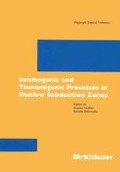Abstract
Stress drop is a fundamental parameter of earthquakes, but it is difficult to obtain reliable stress drop estimates for most earthquakes. Static stress drop estimates require knowledge of the seismic moment and fault area. Dynamic stress drop estimates are based entirely upon the observed source time functions. Based on analytical formulas that I derive for the crack and slip-pulse rupture models, the amplitude and time of the initial peak in source time functions can be inverted for dynamic stress drop. For multiple event earthquakes, this method only gives the dynamic stress drop of the first event. The Michigan STF catalog provides a uniform data base for all large earthquakes that have occurred in the past four years. Dynamic stress drops are calculated for the nearly 200 events in this catalog, and the resultant estimates scatter between 0.1 and 100 MPa. There is some coherent tectonic signal within this scatter. In the Sanriku (Japan) and Mexico subduction zones, underthrusting earthquakes that occur at the up-dip and down-dip edges of the seismogenic zone have correspondingly low and high values of stress drop. A speculative picture of the stress state of subduction zones emerges from these results. A previous study found that the absolute value of shear stress linearly increases down the seismogenic interface to a value of about 50 MPa at the down-dip edge. In this study, the dynamic stress drop of earthquakes at the up-dip edge is about 0.2 MPa, while large earthquakes at the down-dip edge of the seismogenic plate interface have dynamic stress drops of up to 5 MPa. These results imply that: (1) large earthquakes only reduce the shear stress on the plate interface by a small fraction of th absolute level; and thus (2) most of the earthquake energy is partitioned into friction at the plate interface.
Access this chapter
Tax calculation will be finalised at checkout
Purchases are for personal use only
Preview
Unable to display preview. Download preview PDF.
References
Aki, K. and Richards, P.G. Quantitative Seismology (W. H. Freeman, San Francisco 1980) 932 pp.
Boatwright, J. (1980), A Spectral Theory for Circular Seismic Source; Simple Estimates of Dimension,Dynamic Stress Drop, and Radiated Energy, Bull Seismol. Soc. Am. 70, 1–27.
Brune, J.N. (1970), Tectonic Stress and the Spectra of Seismic Shear Waves from Earthquakes,J. Geophys. Res. 75, 4997–5009.
Fukao, Y. (1979), Tsunami Earthquakes and Subduction Processes near Deep-sea Trenches,J. Geophys. Res. 84, 2303–2314.
Heaton, T. (1990), Evidence for and Implications of Self-healing Pulses of Slip in Earthquake Rupture, Phys. Earth and Planet. Int. 8, 25–83.
Kanamori, H. and Anderson, D.L (1975), Theoretical Basis of Some Empirical Relations in Seismology, Bull. Seismol. Soc. Am. 65, 1073–1095.
Kasahara, K. Earthquake Mechanics (Cambridge University Press, Cambridge 1981) 248 pp.
Madariaga, R (1976), Dynamics of an Expanding Circular Fault, Bull. Seismol. Soc. Am. 66, 639–666.
Ruff, L.J. and Kanamori, H. (1983), The Rupture Process and Asperity Distribution of Three Great Earthquakes from Long-period Diffracted P Waves, Phys. Earth Planet. Int. 31, 202–230.
Satake, K. (1995), Linear and Nonlinear Computations of the 1992 Nicaragua Earthquake Tsunami, Pure appl. geophys. 144, 455–470.
Sato, T.and Hirasawa, T. (1973), Body Wave Spectrafrom Propagating Shear Cracks, J. Phys. Earth 23, 323–331.
Scholz, C.H. The Mechanics of Earthquakes and Faulting (Cambridge University Press, Cambridge 1990) 439 pp.
Schwartz, S.Y. and Ruff, L.J. (1987),Asperity Distribution and Earthquake Occurrence in the Southern Kuril Islands Arc, Phys. Earth Planet. Int. 49, 54–71.
Tanioka, Y. and Ruff, L.J. (1997), Source-time Functions, Seismol. Res. Lett. 68, 386–400.
Tanioka, Y. Ruff, L.J. and Satake, K. (1997), What Controls the Lateral Variation of Large Earthquake Occurrence along the Japan Trench? The Island Arc 6, 261–266.
Tichelaar, B. and Ruff, L.J. (1993), Depth of Seismic Coupling along Subduction Zones,J.Geophys. Res. 98, 2017–2037.
Zheng, Z. and Rice, J.R. (1998), Conditions under which Velocity Weakening Friction Allows a Salf-healing Versus a Crack-like Mode of Rupture, Bull. Seismol. Soc. Am. 88, 1466–1483.
Author information
Authors and Affiliations
Editor information
Editors and Affiliations
Rights and permissions
Copyright information
© 1999 Springer Basel AG
About this chapter
Cite this chapter
Ruff, L.J. (1999). Dynamic Stress Drop of Recent Earthquakes: Variations within Subduction Zones. In: Sauber, J., Dmowska, R. (eds) Seismogenic and Tsunamigenic Processes in Shallow Subduction Zones. Pageoph Topical Volumes. Birkhäuser, Basel. https://doi.org/10.1007/978-3-0348-8679-6_2
Download citation
DOI: https://doi.org/10.1007/978-3-0348-8679-6_2
Publisher Name: Birkhäuser, Basel
Print ISBN: 978-3-7643-6146-4
Online ISBN: 978-3-0348-8679-6
eBook Packages: Springer Book Archive

